Image Of The Clouds Of Venus Via The European Space Agency

Image of the clouds of Venus via the European Space Agency
(source)
More Posts from Venusearthpassage and Others

Please Build A Cloud City Over Venus
Daily Science Dump: Kepler’s First Law Edition
Bonjour my science nerds. I got a question regarding Kepler’s Three Laws because they can be somewhat confusing. And tbh, they really are. Because they can be a bit of a pain, I’ve decided to break this up into 3 sections, one for each law. They generally follow the same idea: planetary orbits are not circular. The difference between each law resides in the minute details. And because they are really detailed, I wanted to make sure I covered everything of each law so they don’t get confused. Let’s get started!
Kepler’s First Law of Planetary Motion
History
Before we get into the actual laws, we need to understand why these laws are so important. During the 1500s and early 1600s, astronomy was starting to become a big deal. We were trying to figure out where we are in the universe. During this time period, the famous geocentric and heliocentric models were stirring up massive controversy in the Catholic Church (for obvious reasons). Ptolemy brought around the geocentric model, which put Earth at the center. This was a natural thought at the time because it was a religious concept that man was God’s greatest creation, so God would want to put man at the center of everything (little presumptuous on our part tbh). Next, Copernicus said that our Sun was in the center, and all the planets orbit around the sun. This clearly didn’t go down well with the Church because it was the first instance of defying the Catholic Church, therefore defying God. In an attempt to settle down the controversy, Brahe brought around a new theory model, putting the Earth at the center, having the Sun and Moon orbiting the Earth, and then the rest of the planets orbiting the Sun. It was a very far reached model but people bought it. All of these models had one thing in common; all the orbits of the planets were circular. But none of none of the actual data fit with perfect circular orbits. This is where our boi Kepler comes in.

It was long believed that the planets should orbit along circular paths, because a circle is considered an ideal shape. But as I mentioned before, none of the data was fitting the circular shape, particularly Mars. Kepler brought around another shape, the ellipse, to explain the missing pieces of the data. An ellipse is like a flattened circle with some important properties that Kepler used for his laws. His first law focuses more on explaining the patterns of elliptical orbits. The second and third law goes into more detail on the properties of elliptical orbits.
If you’ve taken a simple geometry class, you know the basic principles of ellipses. We know there’s a major-axis and minor-axis (the diameter horizontally and the diameter vertically), the focal points, and eccentricity. All of these are important for planetary orbits. If we take a trip back to geometry, we know that the positions of the focal points affect the eccentricity, which is basically how much it’s being squished (if e = 0 then it’s a perfect circle and if e = 1 it’s a parabola).
All of this geometry going on transfers over into planetary motion. In this case, the Sun acts as one of the focal points. The other focal point is merely imaginary. Mathematically it exists but there’s nothing at that point in space that says “Hey! I’m a focal point for Saturn!”. But we know for sure that the Sun is on of the two focal points. This revelation caused a lot of uproar and many refused to believe it. Partly because the orbit of a lot planets are so close to a perfect circle it’s extremely hard to tell it’s elliptical at all.
Eccentricity has to stay between 0 and 1, like I explained earlier. An eccentricity of 0 is a perfect circle. If it’s 1 or greater, it’s a parabola. For the planetary motion, most of the planets’ eccentricity doesn’t even crack 0.1 (Pluto has a bit over 0.2 but apparently Pluto isn’t a planet #JusticeForPluto). Earth’s eccentricity is currently 0.0167, which means its very very close to a perfect circle. But not quite. To be quite honest, the fact that Kepler was able to figure out that the orbits were not circular is astonishing.
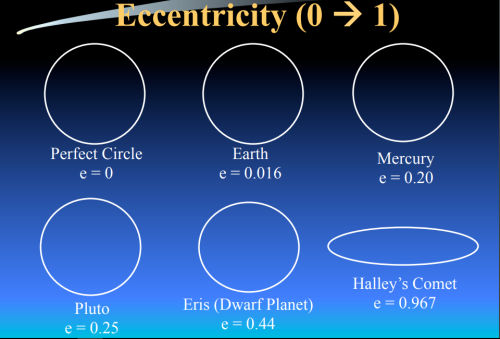
So that’s it for Kepler’s First Law of Planetary Motion! These laws were critical in understanding how our universe works and how our solar system plays out. It opened our eyes to many new ideas and thought processes. This law is just the first step of understanding the orbital tendencies of planets. On Friday, we will dive right into Kepler’s Second Law of Planetary Motion which goes into detail about the speed of the planet due to the elliptical orbit.
Don’t forget, I’m updating the Blog Website everyday with something new because I have no life…. I added cool space music! If you have any cool song recommendations for the playlist definitely shoot me a message!
If you have any questions about today’s Daily Science Dump or any past ones, don’t be afraid to ask!
As always,
Stay Nerdy!
R.L.

Venus over Bioluminescent Algae
Ten interesting facts about Uranus
Like the classical planets, Uranus is visible to the naked eye, but it was never recognised as a planet by ancient observers because of its dimness and slow orbit. Sir William Herschel announced its discovery on 13 March 1781, expanding the known boundaries of the Solar System for the first time in history and making Uranus the first planet discovered with a telescope.

1° Uranus is the seventh planet from the Sun. It has the third-largest planetary radius and fourth-largest planetary mass in the Solar System. Uranus is similar in composition to Neptune, and both have different bulk chemical composition from that of the larger gas giants Jupiter and Saturn.

2° Like all of the giant planets, Uranus has its share of moons. At present, astronomers have confirmed the existence of 27 natural satellites. But for the most part, these moons are small and irregular.

3° Uranus’ moons are named after characters created by William Shakespeare and Alexander Pope. These include Oberon, Titania and Miranda. All are frozen worlds with dark surfaces. Some are ice and rock mixtures. The most interesting Uranian moon is Miranda; it has ice canyons, terraces, and other strange-looking surface areas.

4° Only one spacecraft in the history of spaceflight has ever made a close approach to Uranus. NASA’s Voyager 2 conducted its closest approach to Uranus on January 24th, 1986, passing within 81,000 km of the cloud tops of Uranus. It took thousands of photographs of the gas/ice giant and its moons before speeding off towards its next target: Neptune.

5° Uranus has rings: All the gas and ice giants have their own ring systems, and Uranus’ is the second most dramatic set of rings in the Solar System.
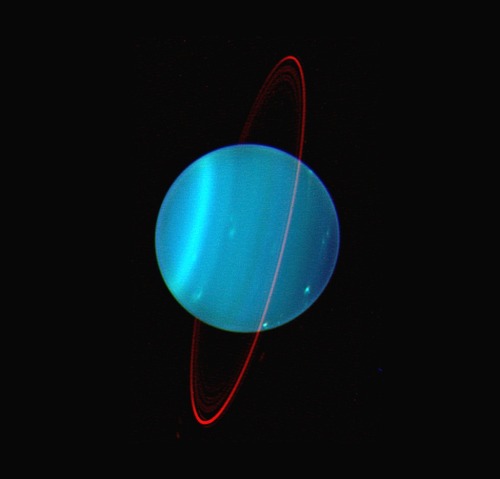
6° Uranus makes one trip around the Sun every 84 Earth years. During some parts of its orbit one or the other of its poles point directly at the Sun and get about 42 years of direct sunlight. The rest of the time they are in darkness.

7° All of the planets in the Solar System rotate on their axis, with a tilt that’s similar to the Sun. In many cases, planet’s have an axial tilt, where one of their poles will be inclined slightly towards the Sun. But the axial tilt of Uranus is a staggering 98 degrees! In other words, the planet is rotating on its side.

8° Uranus is approximately 4 times the sizes of Earth and 63 times its volume.

9° Uranus is blue-green in color, the result of methane in its mostly hydrogen-helium atmosphere. The planet is often dubbed an ice giant, since 80 percent or more of its mass is made up of a fluid mix of water, methane, and ammonia ices.

10° Uranus hits the coldest temperatures of any planet. With minimum atmospheric temperature of -224°C Uranus is nearly coldest planet in the solar system. While Neptune doesn’t get as cold as Uranus it is on average colder. The upper atmosphere of Uranus is covered by a methane haze which hides the storms that take place in the cloud decks.
source 1, source 2, source 2
Images credit: NASA

NASA Study Proposes Airships & Cloud Cities for Venus Exploration
The surface of Venus isn’t going to work for humans, but what if we ignore the surface and stick to the clouds? Dale Arney and Chris Jones, from the Space Mission Analysis Branch of NASA’s Systems Analysis and Concepts Directorate at Langley Research Center, in Virginia, have been exploring that idea. Perhaps humans could ride through the upper atmosphere of Venus in a solar-powered airship. Arney and Jones propose that it may make sense to go to Venus before we ever send humans to Mars.
http://spectrum.ieee.org/aerospace/space-flight/nasa-study-proposes-airships-cloud-cities-for-venus-exploration

Craters on Venus.
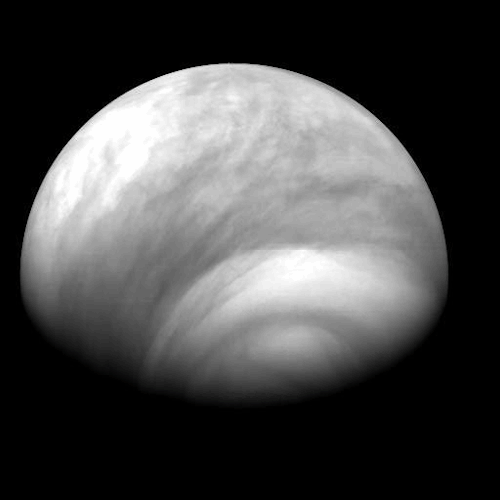
Sequence of Venus atmosphere images taken by the Venus Monitoring Camera (VMC) during the Venus Express orbit in July 2007. The view shows the southern hemisphere of the planet.
Credit: ESA/MPS/DLR/IDA
Shared from Sky News: Venus has more volcanoes than we thought - and this map shows where they are


Clearest image ever taken of Venus. Photo by JAXA.
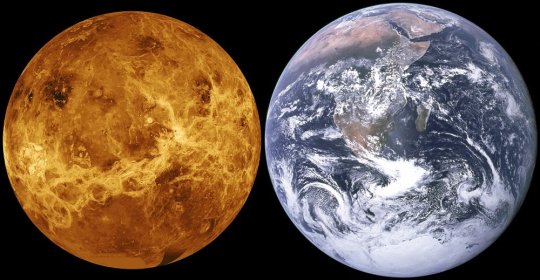
Information on the lack of a Venusian magnetosphere
-
 kimberlyghotic reblogged this · 6 years ago
kimberlyghotic reblogged this · 6 years ago -
 momonthemoveokc-blog liked this · 7 years ago
momonthemoveokc-blog liked this · 7 years ago -
 thisismofo liked this · 7 years ago
thisismofo liked this · 7 years ago -
 crashlandia liked this · 7 years ago
crashlandia liked this · 7 years ago -
 oceana3 liked this · 7 years ago
oceana3 liked this · 7 years ago -
 howstrangethemusicsoundstome reblogged this · 7 years ago
howstrangethemusicsoundstome reblogged this · 7 years ago -
 venusearthpassage reblogged this · 7 years ago
venusearthpassage reblogged this · 7 years ago -
 pikky126 reblogged this · 7 years ago
pikky126 reblogged this · 7 years ago -
 pikky126 liked this · 7 years ago
pikky126 liked this · 7 years ago -
 venusianwonders reblogged this · 7 years ago
venusianwonders reblogged this · 7 years ago